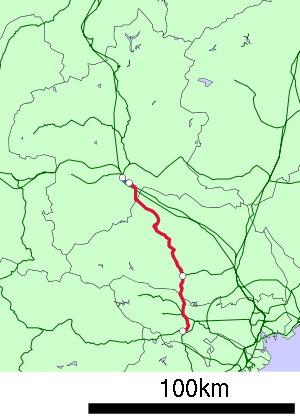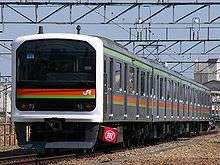Hachikō Line
| Hachikō Line | |||
|---|---|---|---|
|
209 series EMU crossing the Tama River, February 2007 | |||
| Overview | |||
| Native name | 八高線 | ||
| Type | Heavy rail | ||
| Locale | Tokyo Metropolis, Saitama Prefecture, Gunma Prefecture | ||
| Termini |
Hachiōji Kuragano | ||
| Stations | 23 | ||
| Operation | |||
| Opened | 1931 | ||
| Owner | JR East | ||
| Rolling stock | 205-3000 series, 209-3000 series, 209-3100 series, E233 series, KiHa 110 series | ||
| Technical | |||
| Line length | 92.0 km (57.2 mi) | ||
| Number of tracks | Double-track shared with Takasaki Line (Kita-Fujioka - Kuragano) | ||
| Track gauge | 1,067 mm (3 ft 6 in) | ||
| Electrification | 1,500 V DC overhead catenary (Hachiōji - Komagawa) | ||
| |||
The Hachikō Line (八高線 Hachikō-sen) is a 92.0 km regional railway line owned and operated by East Japan Railway Company (JR East). It is located within Tokyo, Saitama, and Gunma Prefectures in Japan. It connects Hachiōji Station in Hachiōji, Tokyo with Kuragano Station in Takasaki, Gunma Prefecture.
Services
Komagawa Station in Hidaka, Saitama is the boundary point between two distinct sections. The southern section from Hachiōji to Komagawa is electrified at 1,500 V DC. Some trains terminate at Komagawa, while others continue over the Kawagoe Line to Kawagoe Station. A few trains leave the Hachikō Line at Haijima Station, entering the Ōme Line and terminating at Tokyo Station.
The non-electrified northern section connects Komagawa with Kuragano. All trains continue on the Takasaki Line to Takasaki, where transfer to the Jōetsu Shinkansen is available. There are no through services connecting the southern and northern halves of the line.
The Hachikō Line takes the first kanji of its name from the first character of Hachiōji (八王子) and the second kanji from the first character of Takasaki (高崎).
Stations
- All trains stop at every station.
- Stations marked "o" or "^" allow passing; stations marked"|" do not. Stations marked "∥" are double-tracked.
Rolling stock
- 205-3000 series 4-car EMUs x 5 (Kawagoe Line/Hachikō Line services since 11 November 2003)[1]
- 209-3000 series 4-car EMUs x 4 (Kawagoe Line/Hachikō Line services since 16 March 1996)[2]
- 209-3100 series 4-car EMUs x 2 (Kawagoe Line/Hachikō Line services since 17 April 2005)[2]
- E233 series EMUs (Chūō Line (Rapid) through services between Komagawa and Haijima, since 17 March 2007)[1]
- KiHa 110 series DMUs (formed as 1- to 3-car trains for services north of Komagawa) (since 18 March 1993)[1]
Rolling stock previously used
- KiHa 35 DMUs (until 15 March 1996)[1]
- 103-3000 series EMUs (from March 1985 until October 2005)[2]
- 103-3500 series EMU (from March 1996 until March 2005)[2]
- 201 series EMUs (Chūō Line (Rapid) through services between Komagawa and Haijima, until March 2008)
 KiHa 35 DMUs passing at Yorii Station, August 1992
KiHa 35 DMUs passing at Yorii Station, August 1992- Komagawa Station with a variety of rolling stock visible, August 2003
History
The first section of the line, named the Hachiko North Line (八高北線), opened from Kuragano to Kodama on 1 July 1931, followed by the section from Hachioji to Higashi-Hanno, named the Hachiko South Line (八高南線), on 10 December 1931.[1] The Hachiko North Line was extended southward from Kodama to Yorii on 25 January 1933, and the Hachiko South Line was extended northward from Higashi-Hanno to Ogose on 15 April 1933.[1] The Hachiko South Line was further extended northward from Ogose to Ogawamachi on 24 March 1934, and the last section between Ogawamachi and Yorii opened on 6 October 1934, connecting the north and south sections, and completing the entire line, which became known simply as the Hachiko Line.[1]
All passenger operations were switch from steam haulage to electric trains from 20 November 1958.[1]
CTC signalling was commissioned over the entire line from 27 February 1985.[1] On 1 April 1987, with the privatization and splitting of Japanese National Railways (JNR), the Hachiko Line was transferred to the ownership of JR East.[1]
From 16 March 1996, the Hachioji to Komagawa section was electrified at 1,500 V DC from 16 March 1996, and services on the non-electrified section north of Komagawa to and from Takasaki were operated separately as wanman driver only operation services using KiHa 110 series DMUs.[1][3]
Former connecting lines
- Komagawa station - A freight-only line serving the Nippon Cement works in Hidaka operated from 1963 until 1984, which also connected to Nishi-Oya on the Tobu Ogose Line.[4]
Accidents
In 1945, a head-on collision at the Tamagawa bridge resulted in 105 fatalities.
The Hachiko Line derailment in 1947 is Japan's worst rail accident since World War II in terms of fatalities.
References
| Wikimedia Commons has media related to Hachikō Line. |
- 1 2 3 4 5 6 7 8 9 10 11 埼玉のローカル線のんびり旅 [Saitama Rural Railway Line Leisurely Trips] (in Japanese). Japan: Mikishobou. 31 July 2013. p. 59. ISBN 978-4-906799-26-8.
- 1 2 3 4 "川越線に209系3100代を投入 103系を置換え" [209-3100 series introduced on Kawagoe Line - Replacing 103 series]. Railway Journal. Japan: Tetsudō Journal. 39 (465): 106. July 2005.
- ↑ JR気動車客車編成表 '04年版 [JR DMU & Coaching Stock Formations - 2004]. Japan: JRR. 1 July 2004. p. 197. ISBN 4-88283-125-2.
- ↑ Kawashima, Ryozo (February 2011). 日本の鉄道 中部ライン 全線・全駅・全配線 第11巻 埼玉南部・東京多摩北部 [Railways of Japan - Chubu Line - Lines/Stations/Track plans - Vol 11 Southern Saitama and Northern Tama Tokyo]. Japan: Kodansha. p. 68. ISBN 978-4-06-270071-9.
.jpg)





.svg.png)